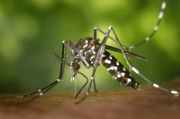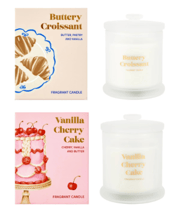This 'unlikely' product is the best thing for removing stubborn cordial stains from countertops
- Replies 11
Imagine this scenario: You've had a long day, and after you get home, you decide to relax for a while on the couch. Then, feeling the need for a drink, you go into the kitchen to get a glass and a bottle of your favourite cordial.
You didn't realise, though, that while pouring the drink, you had slightly missed the glass's mouth, leaving a puddle of coloured liquid on your countertop.
Prioritising your drink, you returned to the couch to watch some television with the mindset that you could always tidy up the small mess later.
You had no idea, though, that once the small pool of cordial that had been sitting on the countertop had dried up, it would be much more difficult to remove and clean up.
That is probably what happened to this one mum from Ballarat, who had to ask for help on social media to remove the red cordial stain off her white kitchen bench.
Sharing on a popular cleaning Facebook group, the woman thought the marks would 'fade over time,' but she was wrong. The stain had not budged, and no amount of cleaning products was able to remove it.
Nearing her limit, she decided to ask fellow cleaners on social media for suggestions.

In a Facebook post, the mum said a stain on her kitchen bench 'wouldn't budge.' Credit: Facebook.
The mum asked for proven and effective cleaning tips on social media, and she received dozens of responses from fellow homeowners offering their advice.
'Cordial is the worst! Have you tried letting spray sit for a few hours? I use earth spray because I like the smell but for a tough stain like this, you have to let it sit for a while,' one woman suggested.
A second person wrote, 'Try using the ALDI Di San spray and let it sit for a minute. It works for hair dye, I found that out during lockdown.'
'Gumption. We use it on light surfaces in the canteen for jelly and ice block marks. Or a cream cleanser,' added a third.
It wasn't known if the woman actually tried all the suggestions given the overwhelming number of comments she had received.
Much later, she revealed that she eventually found an effective, and rather unexpected, cleaner to remove the stubborn stain – mould cleaner and bleach.
Although experts do not recommend using mould remover to clean mould because it only masks the spores rather than removing them, the product does contain bleach, which has been proven to be effective in getting rid of marks and stains.
'Thanks all. Tried a bit of mould remover/bleach and worked a treat,' the Ballarat mum said in the comments.
We do want to remind you, members, to never mix chlorine bleach solution with other cleaning solutions or detergents that contain ammonia (like mould cleaners).
Toxic fumes can be produced that may be life-threatening. Carefully read all ingredients on your cleaning supplies and if in doubt, do not mix them.

The food colouring in cordial is a dye that will stay on any surface for a long time, so you should be careful. Credit: Shutterstock/Angie Yeoh.
Since most of us here probably prefer tea over cordial, here are some tips on how to get rid of tea stains on any surface:
Bicarbonate of soda is a cheap household item that most people already have in their cupboards, and as it turns out, it's also a holy grail for cleaning stains!
Mugs and teaspoons
Mix two teaspoons of bicarbonate of soda with a few drops of water to make a loose paste. Then, rub the paste on stained teacups, mugs, teaspoons, and any other kitchen tool with a soft cloth.
If you don't have any bicarbonate of soda, you can use white vinegar and table salt instead. Soak a cloth in white vinegar and then dip it in table salt.
To avoid stains, rinse the utensils immediately after use, even if you don't have time to thoroughly wash them.
Carpet
Soak up as much of the stain as you can, and then use a product made specifically for removing stains from carpets.
Spray the product onto the stain and let it soak for five minutes. Use a clean cloth to dab the area.
In case a carpet cleaner causes discolouration, it is a good idea to test it on a small area of carpet first.
Clothing
First, act quickly and use a paper towel or soft cloth to soak up as much of the liquid as you can.
Do not apply salt to the stain. If you put milk in your tea, make sure to use cool water because the proteins in the milk could cause the stain to become permanent if you use hot water.
Use a product designed to remove stains from clothing, and then wash the item according to the instructions provided with it.
Worktops
Using the same mixture of bicarbonate of soda and water that you use to clean mugs and teaspoons is the best way to get rid of tea stains on a worktop.
On laminate or wooden worktops, you can also use half a lemon dipped in salt.
Granite and marble countertops should be easy to clean, but if they are stained, you'll need to be more careful. You can use a solution made with dishwashing liquid, which should do the trick, or you can use a cleaner designed specifically for worktops.
And for hard water stains, check out the video below!
Credit: Fix It Now.
What are your thoughts, folks? Do you have more stain-cleaning tips and tricks to share with us? Let us know in the comments!
You didn't realise, though, that while pouring the drink, you had slightly missed the glass's mouth, leaving a puddle of coloured liquid on your countertop.
Prioritising your drink, you returned to the couch to watch some television with the mindset that you could always tidy up the small mess later.
You had no idea, though, that once the small pool of cordial that had been sitting on the countertop had dried up, it would be much more difficult to remove and clean up.
That is probably what happened to this one mum from Ballarat, who had to ask for help on social media to remove the red cordial stain off her white kitchen bench.
Sharing on a popular cleaning Facebook group, the woman thought the marks would 'fade over time,' but she was wrong. The stain had not budged, and no amount of cleaning products was able to remove it.
Nearing her limit, she decided to ask fellow cleaners on social media for suggestions.
In a Facebook post, the mum said a stain on her kitchen bench 'wouldn't budge.' Credit: Facebook.
The mum asked for proven and effective cleaning tips on social media, and she received dozens of responses from fellow homeowners offering their advice.
'Cordial is the worst! Have you tried letting spray sit for a few hours? I use earth spray because I like the smell but for a tough stain like this, you have to let it sit for a while,' one woman suggested.
A second person wrote, 'Try using the ALDI Di San spray and let it sit for a minute. It works for hair dye, I found that out during lockdown.'
'Gumption. We use it on light surfaces in the canteen for jelly and ice block marks. Or a cream cleanser,' added a third.
It wasn't known if the woman actually tried all the suggestions given the overwhelming number of comments she had received.
Much later, she revealed that she eventually found an effective, and rather unexpected, cleaner to remove the stubborn stain – mould cleaner and bleach.
Although experts do not recommend using mould remover to clean mould because it only masks the spores rather than removing them, the product does contain bleach, which has been proven to be effective in getting rid of marks and stains.
'Thanks all. Tried a bit of mould remover/bleach and worked a treat,' the Ballarat mum said in the comments.
We do want to remind you, members, to never mix chlorine bleach solution with other cleaning solutions or detergents that contain ammonia (like mould cleaners).
Toxic fumes can be produced that may be life-threatening. Carefully read all ingredients on your cleaning supplies and if in doubt, do not mix them.
The food colouring in cordial is a dye that will stay on any surface for a long time, so you should be careful. Credit: Shutterstock/Angie Yeoh.
Since most of us here probably prefer tea over cordial, here are some tips on how to get rid of tea stains on any surface:
Bicarbonate of soda is a cheap household item that most people already have in their cupboards, and as it turns out, it's also a holy grail for cleaning stains!
Mugs and teaspoons
Mix two teaspoons of bicarbonate of soda with a few drops of water to make a loose paste. Then, rub the paste on stained teacups, mugs, teaspoons, and any other kitchen tool with a soft cloth.
If you don't have any bicarbonate of soda, you can use white vinegar and table salt instead. Soak a cloth in white vinegar and then dip it in table salt.
To avoid stains, rinse the utensils immediately after use, even if you don't have time to thoroughly wash them.
Carpet
Soak up as much of the stain as you can, and then use a product made specifically for removing stains from carpets.
Spray the product onto the stain and let it soak for five minutes. Use a clean cloth to dab the area.
In case a carpet cleaner causes discolouration, it is a good idea to test it on a small area of carpet first.
Clothing
First, act quickly and use a paper towel or soft cloth to soak up as much of the liquid as you can.
Do not apply salt to the stain. If you put milk in your tea, make sure to use cool water because the proteins in the milk could cause the stain to become permanent if you use hot water.
Use a product designed to remove stains from clothing, and then wash the item according to the instructions provided with it.
Worktops
Using the same mixture of bicarbonate of soda and water that you use to clean mugs and teaspoons is the best way to get rid of tea stains on a worktop.
On laminate or wooden worktops, you can also use half a lemon dipped in salt.
Granite and marble countertops should be easy to clean, but if they are stained, you'll need to be more careful. You can use a solution made with dishwashing liquid, which should do the trick, or you can use a cleaner designed specifically for worktops.
And for hard water stains, check out the video below!
Credit: Fix It Now.
What are your thoughts, folks? Do you have more stain-cleaning tips and tricks to share with us? Let us know in the comments!







